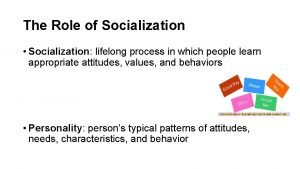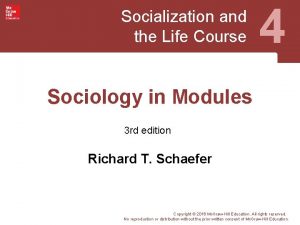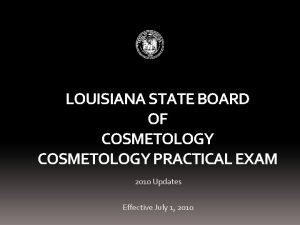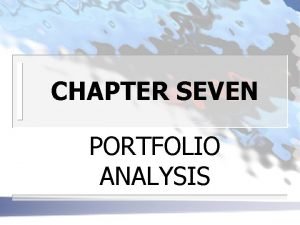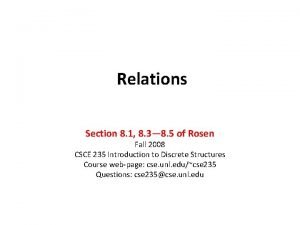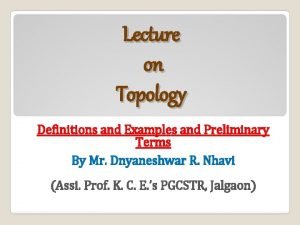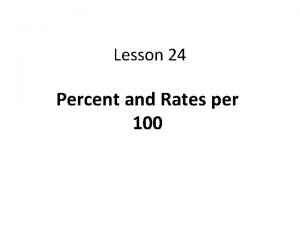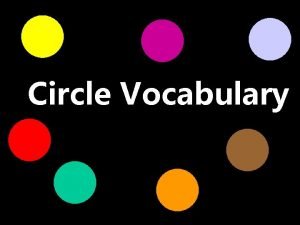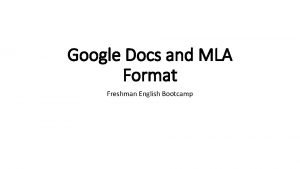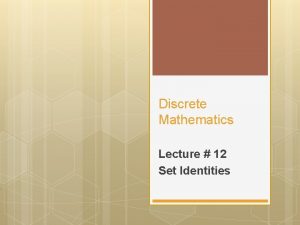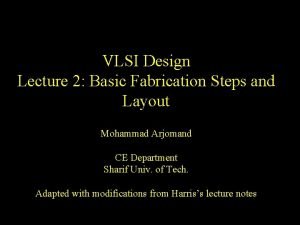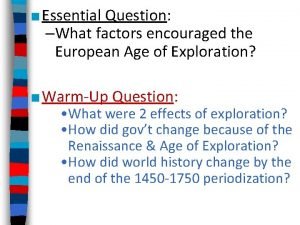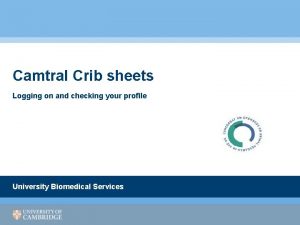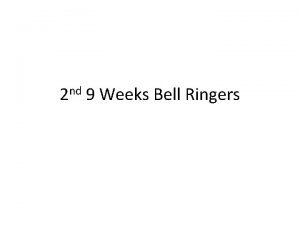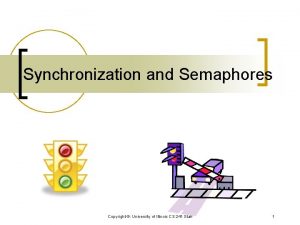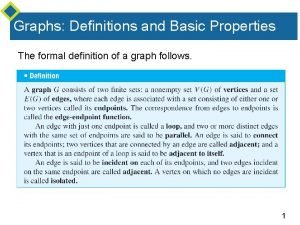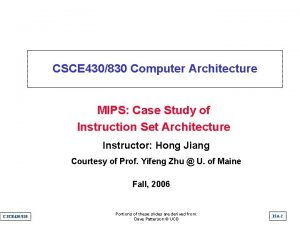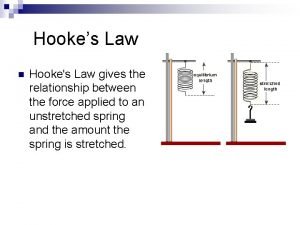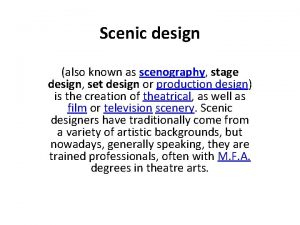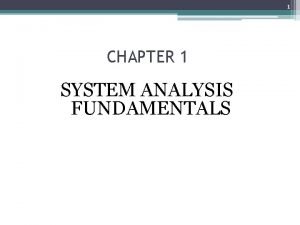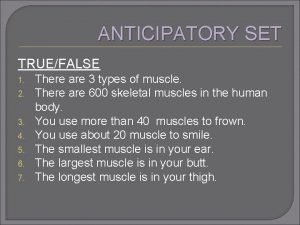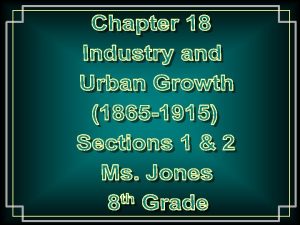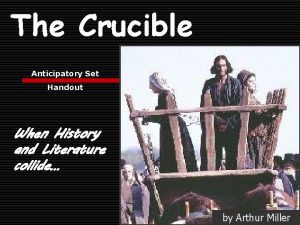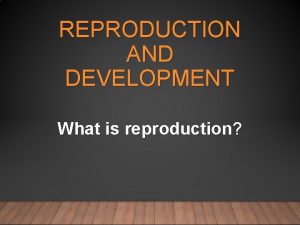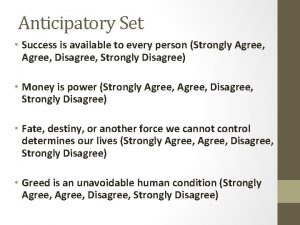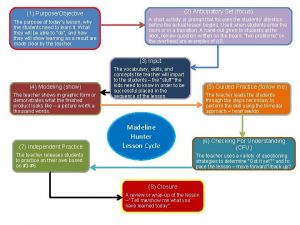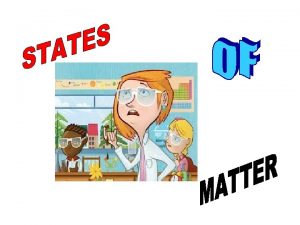Anticipatory Set 9 15 11 Anticipatory Set 9


























































- Slides: 58

Anticipatory Set 9 -15 -11

Anticipatory Set 9 -21 -11 L 2&3

Cellular Transport

Selective Permeability ⌂ Selective permeability- the cell membrane’s ability to allow some substances to enter/ exit but not all. ⌂ Two processes that allow substances to enter/exit: • Passive transport – energy from kinetic energy and concentration gradient. • Active transport-ATP

Diffusion ⌂ Process depends on concentration gradient. • Particles will never stop moving, but when equilibrium is reached there will be no net change in their concentration. • Movement of particles is from [high] to [low] concentration. • Dependent on four factors: diameter, temperature, electrical charge (when applicable), and the concentration gradient. • Majority of materials enter cell through diffusion…energy conservation for other processes.

Cell Membrane & Diffusion ⌂ diffusion animation

Osmosis ⌂ Diffusion of water. ⌂ Water always travels from hypotonic to hypertonic ⌂ Solute always travels in opposite direction of water. ⌂ Osmosis Animation

Isotonic Solutions ⌂ Isotonic solutions-the same amount of solute exists inside and outside the cell. ⌂ Water moves in and out at the same rate.

Hypertonic Solutions ⌂ Hypertonic solutionshave more solutes in solution than inside the cell. ⌂ Water moves out of the cell to achieve equilibrium.

Hypotonic Solutions ⌂ Hypotonic solutionshave less solutes in them than inside the cell. ⌂ Water will enter the cell to try and achieve equilibrium. ⌂ Cells may lyse if too much water enters. ⌂ Plants combat this risk with their cell wall, and turgor pressure results.

Data Set 9

Level 1 and 1

Level 1 & 2

Level 1, 1, 2

Osmoregulation-water control ⌂ Turgid- enough water, plant cell rigid ⌂ Flaccid- lacking water, plant cell limp ⌂ Plasmolysis- cell membrane is ripped from cell wall

. Hypotonic solution Isotonic solution Hypertonic solution Animal cell H 2 O Turgid (normal) H 2 O Flaccid H 2 O Shriveled Normal Lysed Plant cell H 2 O Plasmolyzed

Water Potential- water’s ability to do work when going through the C. M. ⌂ Pressure Potential ⌂ Solute Potentialbased on solute • Positive pressure is the cell being pushed concentration • Negative Pressure- the cell being pulled (eg transpiration)

Positive Pressure Potential

Negative Pressure Potential

Solute Potential ΨS = -i. CRT -i (ionization constant) C (molar concentration) R (pressure constant) T (temperature in Kelvin)

Turgor pressure is ~100 psi, much more than a tire. The pressure is so great that plant cells would detach from one another if not for adhesive molecules known as pectins.

Facilitated Diffusion with Channel Proteins ⌂ Facilitated diffusionwithin the cell membrane are channel proteins that allow materials to pass into the cell. ⌂ Aquaporins- channel proteins that allow water to pass through, in addition to simple diffusion. • In kidneys and plants where water is essential • Channel Protein Animation

FD with Ion Channel Proteins ⌂ Channel protein let in ions. ⌂ When the protein shape changes, the gate will open. ⌂ Ions pass through based on size and charge. ⌂ Can be ligand gated or voltage gated. ⌂ Voltage gated channels depend on two things: • Concentration gradient of K § Concentration of K (usually higher inside cell) • Membrane potential due to charge imbalance.

Anticipatory Set 9 -22 -11 Level 3

Facilitated Diffusion with Carrier Proteins ⌂ Carrier proteins transport polar substances like amino acids and sugars. ⌂ When the carrier proteins become saturated the rate of diffusion is maxed out. ⌂ Animation: How Facilitated Diffusion Works

Figure 5. 12 A Carrier Protein Facilitates Diffusion (Part 1)

Filtration ⌂ Filtration- pressure driven system that pushes water and nutrients across cell membranes. ⌂ This is how urine is produced ⌂ Does not require energy.




Active Transport

Active Transport is Directional ⌂ Active transport always works against the concentration gradient. Going from a lower to higher concentration. ⌂ Requires energy. ⌂ Two types: primary and secondary active transport.

Membrane Proteins associated with Active Transport ⌂ Cell Pumps: ⌂ Uniports move a single substance in one direction. ⌂ Symports – move two substances in the same direction. ⌂ Antiports - move two substances in opposite directions. One into the cell, and one out of the cell. • e. g. Na. K pump • Coupled transporters are those that move two substances. Which of these are coupled?

Figure 5. 13 Three Types of Proteins for Active Transport

Primary Active Transport ⌂ ATP is hydrolyzed and drives the movement of ions against the concentration gradient. ⌂ Sodium potassium pump is an example of 1 AT. Because the ions move against the concentration gradient. (Na leaves cell, although more Na outside cell, same with K more in cell, but K still enters) ⌂ Na. K Pump located in all animal cells; antiport; coupled transporter ⌂ Na. K Pump Simple Animation ⌂ Na K Pump Animation

Figure 5. 14 Primary Active Transport: The Sodium–Potassium Pump

Membrane Potential ⌂ Membrane Potential aka Voltage Gradient allows the cell to do work. ⌂ DNA is negative inside cell(-), Na. K pumps extra Na out of the cell (+). ⌂ Difference in charge allows molecules to be transported using ATP. ⌂ E. g. glucose enters through because of membrane potential ⌂ Secondary AT Animation

H Pumps ⌂ Most important pump for cell respiration and photosynthesis. ⌂ H+ pumped out of cell, and ions can now diffuse in ⌂ Pumping H requires little energy, and they help sugars enter the cell by AT




What if the macromolecules are too large, charged, or polar to enter through the membrane? ⌂ Is this a good problem or not? ⌂ Which organelle is responsible for substance transport?

Endocytosis ⌂ Processes that bring substances into the cell such as macromolecules and smaller cells. ⌂ Three types of endocytosis: • Phagocytosis • Pinocytosis • Receptor-Mediated Endocytosis

Figure 5. 16 Endocytosis and Exocytosis (A) Phagocytosis • Cell eating • Part of cell membrane engulfs particles/cells • Phagosome fuses with a lysosome and digestion occurs

Endocytosis ⌂ Phagocytosis- process fairly nonspecific ⌂ Only a few cells can do this ex. WBC • Must be able to change shape and form pseudopodia. • WBC will attach to bacteria engulf bacteria with pseudopodia lysosomes with enzymes digest it residual waste is exocytosed. • Pinocytosis- same process just with liquids. Also fairly nonspecific. • WBC and Phagocytosis Animation

Receptor-Mediated Endocytosis ⌂ Specific process that utilizes integral membrane proteins to bind to specific molecules in the cell’s environment. ⌂ Receptor proteins are substance specific, aka coated pits. Coated with protein , formed by CM depressions. ⌂ When a ligand binds to the receptor protein, it invaginates and forms a vesicle. ⌂ E. g. cholesterol uptake in mammals rd. 113 -114

Figure 5. 17 Formation of a Coated Vesicle (Part 1)

Figure 5. 17 Formation of a Coated Vesicle (Part 2) Receptors will form a new vesicle and be recycled back to plasma membrane.

Exocytosis ⌂ Anything that comes in must go out. ⌂ Materials are packaged into vesicles, which fuse with the cell membrane via a membrane protein. ⌂ The two membranes fuse, contents expelled, and the CM incorporates vesicle membrane.

Endocytosis and Exocytosis Animation Hyper, Hypo, Iso

Other Cell Membrane Functions ⌂ Some organelle membranes help transform energy. ⌂ Some membrane proteins organize chemical reactions. ⌂ Some membrane proteins process information.

Plasmolysis ⌂ Net loss of a cell’s volume due to a hypertonic environment. ⌂ Plasmolysis Animation

Water Potential ⌂ Tendency of water to leave one place in favor of another. ⌂ Always moves from higher to lower water potential. ⌂ Affected by pressure and solute ⌂ Water potential ( ) = pressure potential ( p) + solute potential ( s) ⌂ Solute Potential = s=–i. CRT • i = The number of particles the molecule will make in water; for Na. Cl this would be 2; for sucrose or glucose, this number is 1 • C = Molar concentration (from your experimental data) • R = Pressure constant = 0. 0831 liter bar/mole K • T = Temperature in degrees Kelvin = 273 + °C of solution ⌂

Water Pot. and Plasmolysis

Lab: Plasmolysis ⌂ Perform a serial dilution of salt (100, 50, 25, 0% solution) ⌂ Predict which solution will yield the fastest plasmolysis results. ⌂ Perform Experiment with each solution and time results.

Lab: Water Potential ⌂ Perform a serial dilution of sugar ( 100, 50, 25, 0). Label solutions. ⌂ Core equal lengths of 2 vegetables. ⌂ Record lengths, mass, and vegetable type in table. ⌂ Predict what will happen to length and mass by tomorrow.

Anticipatory Set 10 -10 -11 Level 2

 Anticipatory set ideas
Anticipatory set ideas Define anticipatory set
Define anticipatory set Anticipatory guidance definition
Anticipatory guidance definition Anticipatory set
Anticipatory set Total set awareness set consideration set
Total set awareness set consideration set Training set validation set test set
Training set validation set test set Anticipatory guidance for autism
Anticipatory guidance for autism Socialization process
Socialization process Anticipatory guidance for adults
Anticipatory guidance for adults Anticipatory care definition
Anticipatory care definition Arnim wiek
Arnim wiek Example of anticipatory socialization
Example of anticipatory socialization Desocialization definition
Desocialization definition Leaflet anticipatory guidance
Leaflet anticipatory guidance Types of socialization
Types of socialization Anticipatory care calendar
Anticipatory care calendar What is anticipatory bail
What is anticipatory bail Anticipatory socialization
Anticipatory socialization Crisp set vs fuzzy set
Crisp set vs fuzzy set Bounded set vs centered set
Bounded set vs centered set What is the overlap of data set 1 and data set 2?
What is the overlap of data set 1 and data set 2? Crisp set vs fuzzy set
Crisp set vs fuzzy set The function from set a to set b is
The function from set a to set b is Crisp set vs fuzzy set
Crisp set vs fuzzy set Overhead applied formula
Overhead applied formula Music gcse edexcel past papers
Music gcse edexcel past papers Manicurist practical exam
Manicurist practical exam Efficient set theorem
Efficient set theorem Solving a compound linear inequality interval notation
Solving a compound linear inequality interval notation Transitive relation example
Transitive relation example Closure of a set
Closure of a set Software is a set of instructions
Software is a set of instructions Lesson 24 percent and rates per 100
Lesson 24 percent and rates per 100 Cardinal number of a set
Cardinal number of a set Circle set
Circle set Instruction set of 8085
Instruction set of 8085 National indicator set
National indicator set How to do mla header on google docs
How to do mla header on google docs Corelea
Corelea Arquitetura risc e cisc
Arquitetura risc e cisc Which command is used to set terminal io characteristic
Which command is used to set terminal io characteristic Identity law discrete math proof
Identity law discrete math proof 6.6 proportions in similar triangles
6.6 proportions in similar triangles Inverter mask set
Inverter mask set What factors most inspired conquistadors to set sail?
What factors most inspired conquistadors to set sail? Log crib set
Log crib set Laws that regulate public conduct
Laws that regulate public conduct Zp set meaning
Zp set meaning Lc3 cheat sheet
Lc3 cheat sheet Rough set theory
Rough set theory I set the table at the andersons house on saturday
I set the table at the andersons house on saturday Hitlers lightning war
Hitlers lightning war Semaphores
Semaphores Vertex set
Vertex set Mips instruction set
Mips instruction set Hooke's law set up
Hooke's law set up Define floor plan or scenic design.
Define floor plan or scenic design. What is the domain of the set of ordered pairs
What is the domain of the set of ordered pairs A set of related components that produces specific results
A set of related components that produces specific results







